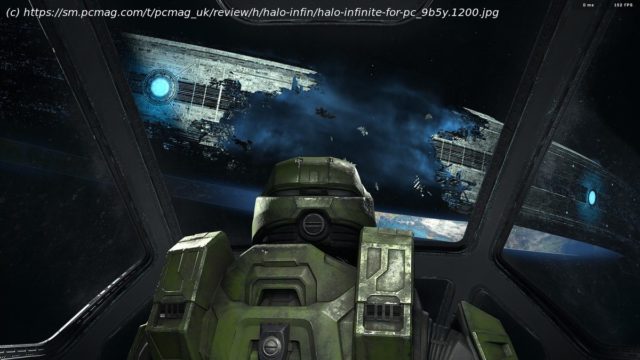A reimagined, revived Halo
There is a mighty weight of expectations surrounding Halo Infinite, following two less positively received main entries and six-year wait since Halo 5’s release. Thankfully, Halo Infinite’s free multiplayer relieved much of the concern when it dropped days before the game’s official launch. It plays fantastically on PC, a weighty mix of classic and modern Halo that brings the past games’ satisfying matchmaking experiences into the present. The single player campaign that comes with the $59.99 PC game has its issues, but stands as a successful and robust reimagining of what Halo should look like in 2021. The writing is mostly strong, the story is compelling, and the cutscenes look great. A new open-world map design with optional map markers and collectibles, as well as ability upgrades including the brilliant addition of a grappling hook, breathes fresh life into a traditionally linear experience. Some map elements aren’t new to video games by any stretch, but they’re new to Halo, and work well. Halo Infinite is the franchise’s big chance to put itself back at gaming’s forefront, and between the campaign and gripping multiplayer action, it’s safe to say that Halo is back. Forward Unto Dawn Despite the many years of buildup, Halo Infinite’s campaign format remained a mystery, until, well, I launched the game and began playing. There were open-world expectations, but that can mean a lot of things in modern games. The reality is that Halo Infinite lands somewhere between a true open-world map and traditional Halo campaigns, and the result is largely successful. First, the story. The game begins in media res, chaining off Halo 5 ‘s conclusion. Without spoiling anything, I’ll say up front that past titles’ events significantly inform Halo Infinite’s narrative. New players, or people who have forgotten past story beats, may be a little lost. This game’s events aren’t hard to follow in and of themselves, but the significance of Halo rings, Cortana, and the different factions can be confusing, and are frequently referenced. The way the story is told—covering past events and the time jump after Halo 5’s ending as character moments or reveals, rather than exposition dumps—helps alleviate this to a degree. You gain more clarity as you play, and a lot of questions are answered the further you go with a type of flashback or dialogue. Details about the current status of the factions and characters are provided through smaller comments (and audio logs you can find) rather than explicitly explained. It’s a more mature, grown-up method of storytelling for Halo, even if some of it is still relatively cheesy talk about saving the galaxy from bombastic villains. That said, the narrative leans heavily on the series’ lore—Halo’s story has always been more complex and weirder than you’d expect it to be from the outside. Some fans are deeply invested in Halo’s lore courtesy of the series’ games, books, and spin-offs (like Halo Wars), but I imagine that it will not always be clear what is new information to this game, who everyone is, or what event they’re referring to. It’s been a long time, and there are a lot of names thrown around. The story could use more exposition. The game’s main villain, a hulking, shouting Brute named Escharum (who you probably saw monologuing in the game’s trailers) is a mostly one-note character, but he’s a fine enough big bad with some depth. Fortunately, there’s more going on than just fighting his Banished faction, as Chief uncovers the secrets of a new Halo ring, and deals with his own personal guilt, trust, and failures. There’s enough mystery to keep you invested in the narrative, and the cutscenes (particularly character models and lighting) are wonderful. The dialogue between Chief and his new AI companion is the story’s core, and the writing on display is one of the game’s better aspects. It’s often humorous, but there’s a particularly somber stretch that made me genuinely feel bad when her feelings were hurt. Her expressive facial animations help sell the moments, and only occasionally veer into the uncanny valley. The character is new and comes off as very innocent, which is a nice contrast to the other characters. The AI companion also provides a reason for Chief to explain things to her (and you). Halo Infinite’s soundtrack also deserves praise, providing a mix of atmospheric exploration music, thrilling combat tracks, and songs and compositions that exist somewhere in between. It all sounds very Halo, particularly the vocal- and percussion-heavy tracks. The score isn’t trying as hard to be edgy as some music in the previous titles. I also mentioned the classic theme, deployed perfectly and sparingly in a few key moments to really get the blood pumping. There are great, new tracks too, composed by a trio of composers with a varied (and indie game heavy) background. As a story, Infinite is definitely “more Halo,” and all that entails: Space drama, soaring music (I dare you not to get chills the first time the theme kicks in), and a little dialogue cheese. Still, it’s far more compelling than Halo 4 or 5. A lot of it sounds melodramatic, but that’s also par for the Halo course. It’s still a lot of fun, and feels more mature when needed. There are clear dramatic and emotional stakes (mostly earned, some moments less so), and fighting back from a place of defeat at the start of the game is satisfying. The Halo Infinite campaign goes back to the roots, both in style and the fact that it takes place on a Halo ring. Is this a type of fan service to get players back onside after two disappointing campaigns? Possibly, though it is one that works, and feels closer to what people love about the earlier titles. That said, Infinite features significant new turns. Unlike past titles, Halo Infinite isn’t just a sequence of story missions with cutscenes in between. The story missions are linear as in the other Halo games, often set in an interior location. You’re in the mission until you’ve completed your objective, and the scripted events finish. That said, you start a mission by actively navigating to it on the open-world map, a key difference from a chain of missions with a start and end. You can’t talk about the campaign beyond the story, though, without discussing this much-speculated-about map. Welcome to Zeta Halo: How Open is the World? The game takes place on a small (relative to the full ringworld) slice of Installation 07, or Zeta Halo, one of the titular Forerunner constructs that helped the original game make its name. Once you’re out of the prologue area, the full explorable 3D map is revealed, which is of course new for a mainline Halo title. Initially, the map may not look particularly large, and indeed it isn’t as massive as some open-world RPGs. I expected that another segment would be later revealed, but the region you’re first shown is the full area. Once you get a gauge for how long it takes to travel distances, the number of activities packed in each segment, and the fact that it’s punctuated by lengthy, instanced campaign missions (which are often interior or underground), you’ll realize that the map is large enough. So, what do you do on this larger map? More of everything. The map is your portal between campaign missions, but it’s also fully explorable, with plenty to do. The most “primary” objective is capturing forward operating bases, or FOBs, which are scattered through the region and sort of control the area. To capture one, you fight off a modestly sized Banished groups and let your AI companion hack the terminal on the main platform. Once captured, marines show up, and Master Chief can order new weapons or call in a vehicle drop. More and better gear is unlocked as you gain Valor for completing missions; this happens pretty passively, and you don’t have to “spend” it, it’s just a way of gating the better gear until later in the game so you feel like you’ve earned something. Capturing your first FOB and being able to order up a sniper rifle would feel a touch unearned, I think, so I like the concept mechanically (even if narratively, they really should be giving Chief their best weapons ASAP!). Think of it as improving the UNSC’s grip on the ring, able to offer you more support with a greater foothold. These help you feel like you’re gearing back up to take on the next area, as their name implies, and the vehicles get you there faster. The next campaign mission is marked in yellow, but (unless restricted at that time by story requirements), you can wait to complete it and go explore the area. Eventually, completing a story mission means you hop into a Pelican and fly off to another region section where you’ll be stuck for a bit to advance the plot. Once you clear another FOB, though, fast travel comes back online, and you can jump back to another FOB to go after more map markers. In addition to the FOBs, there are several other types of activities available on the ring, from collecting item to battling enemies to upgrading gear. These include Spartan Cores that you use to upgrade Master Chief’s abilities. You start with the Grappleshot (which has its own section below, because it rules), but the rest of the abilities themselves are unlocked during story missions. The Spartan cores can be spent on making any ability better—shortening cooldown, adding damage or another effect, giving an extra use of the ability, and more. You can also use them to improve your base shield capacity, ticking it up as you play to last longer in fights. These RPG-like upgrade trees are fairly simple by modern standards, but effective, and all Halo really needs. This is a microcosm of how the campaign, overall, isn’t transformative or groundbreaking compared to modern titles, but still a smart and natural improvement on what past Halo campaigns have been. Other map markers include intel drops in the form of audio logs from UNSC soldiers and the Banished. They expand the lore, and give you additional details about certain characters. I largely found these interesting, though as with most games I sometimes needed to stand there waiting for the audio to complete so I didn’t cut it off with some new in-game dialogue (you can replay the logs in your menu in any case). These logs emit a beep to help you find them, and are usually marked on your map once you are in control of an area. The precise locations aren’t always obvious, though. There were a few times I scoured in an area to uncover them, which was fine by me as it added to the feeling of exploration. There are also larger keeps to assault, with walls and many more enemies than a FOB. These are fun to siege, much like bases in the other open-world games. You may be inclined to stealth your way through, as in other titles, but there’s no such option here—it’s Halo, and you’re meant to fight. Maybe one day, Spartan abilities will evolve to include a full stealth kit (the best you have right now is that the maximum Thrust upgrade grants you active camo for a few seconds after use). There are also assassination target map markers. Your inventory includes dossiers on these particularly dangerous Banished soldiers, elite versions of the different alien species who have an especially violent or impressive service record.






